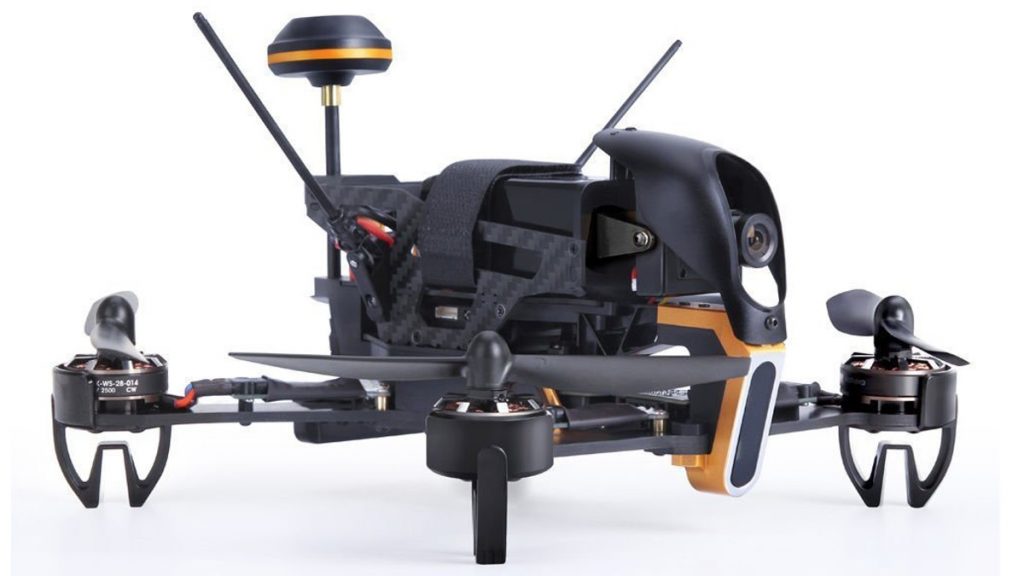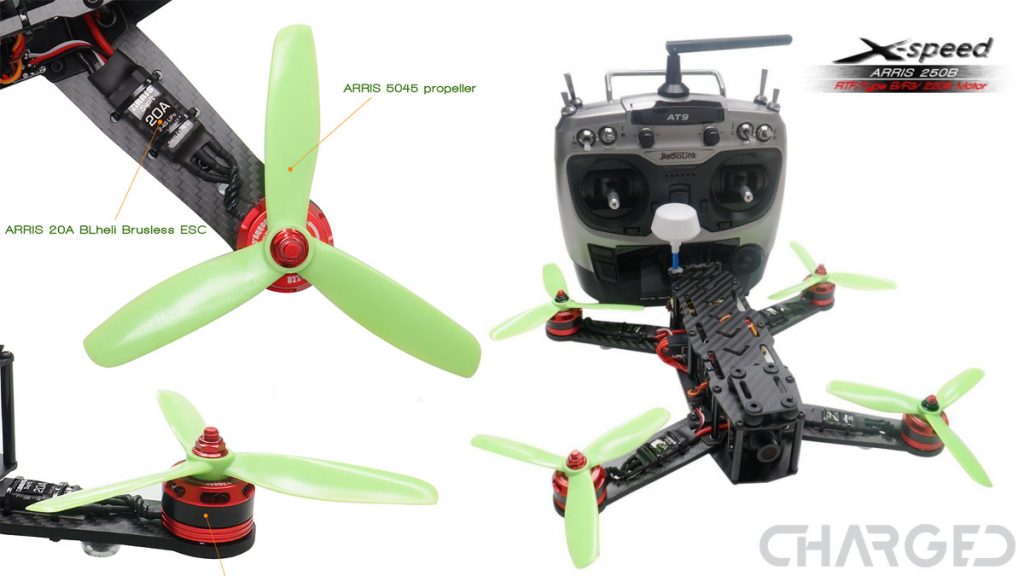You may have seen it in the news, drone racing is fun hobby. You may be thinking about taking your Phantom or Mavic drone to the park to scoot around with your friends, which would be fun, but that’s not what we’re talking about. We’re talking about small, tough, agile, high-speed machines with FPV cameras that maneuver highly technical closed tracks.

With speeds in the neighborhood of 100 mph, technical courses that look like something out of a 90’s video game, and cash prizes on televised races, what’s not to love?!? Compared to high-end camera drones, it is fairly affordable to get started, and we’re here to help with a list of the best racing drones.
(Please note, we really do recommend you custom build your perfect machine for your racing career, but if you are just a casual racer, or need a place to get started, the drones in this list are perfect for you.)
Why trust Drone Rush?
I’ve been a fan of flight since a young age; while I’ve had few opportunities at the helm of manned aircraft, the hours on my fleet of drones continue to grow. I enjoy putting cameras into the sky, silky smooth aerial imagery makes me happy. My goal is to help all pilots enjoy flight legally and safely.
What do you need to race?
Before we dive into the exciting drones that you could be speeding off with, please be sure to understand what it takes to fly. These are very high speed machines, they are more agile in the air than most of us can be ready for the first time out and they offer little to no flight assistance. If nothing else, please take some time to learn on a trainer before going full racing drone. If you would like to know more, please take a peek at these resources:
- Buying a racing drone? Things to know before you fly
- Know the law – do you need to register your racing drone with the FAA?
Best racing drones
Walkera F210 3D


As far as an out-of-the-box solution goes in the racing world, the Walkera F210 3D is one of the best drones you’ll find today. It packs both normal and night vision cameras, a sturdy build, simple customizations and a lot of thoughtful longevity features. Not saying it won’t break if you crash it, but they’ve done what they can to protect core components and make the rest easy to replace.
Best of all, you can tweak the flight characteristics directly, adjusting the flight controller to your specifications. The F210 3D is lightweight, we hear it is extremely agile, particularly in those demanding corners of technical courses, and is fast enough to keep up.
We can’t guarantee you’ll win races with the Walkera F210 3D, but if any ready to fly drone purchase was going to get you there, this may be it.
Check out the Walkera F210 3D for $349 on Amazon today.
Emax Hawk 5

We have to admit, the Emax Hawk, and smaller BabyHawk have been on our radar, but didn’t make our list. That is, until we attended the IDRA races at AUVSI Xponential in Denver, the winning racer was flying a Hawk. Pilot skill aside, that’s enough credibility for our list. Hawk 5 is a bit of a larger racing quad, but it’s super fast. Maneuverability is key to keeping speed through a tight course, and the Hawk performed beautifully at the race.
Check out the Emax Hawk Sport 5 for $250 as a Bind-and-Fly configuration – meaning you need your own controller.
Arris X-Speed 250B

A simple design with advanced electronics makes the Arris X-Speed 250B an appealing package. That, and the fact that you pretty much just have to charge the batteries and you’re ready to fly out of the box. Equipped with some assistive flight modes, for the learning flier or lazy flying days, this could be a great package for a new racing pilot.
Check out the light-weight, ready to fly Arris X-Speed 250B for $299 on Amazon today. (The larger 280 model is $309 right now.)
Walkera Furious 215

A newer machine from Walkera, this 215mm frame size racer is geared up for the win. Walkera includes a long list of features with this little racing machine. A well equipped camera will keep you enjoying up to 9 minutes of flight from this ready-to-fly package. It weighs 375g without a battery and you can get it in kits with various controllers, or no controller at all.
Check out the Walkera Furious 215 from $435 with a simple controller, up to $662 with high-end controller.
Fat Shark 101

We all have to start somewhere, and Fat Shark is determined to help us all get into racing. I was impressed with the simplicity of the build for the Fat Shark 101 race trainer, almost as impressed by its speed and how complete of a racing package you get for the money. Scoot along and learn all the basics of racing using this cool looking, easy flying drone.
The Fat Shark 101 is $199 today.
Build your own racing drone
Truth is, most racers prefer to build their machine from the ground up. Scratch building your racing drone ensures you get the form factor of your desire, and has the added benefit of helping you understand each of the components so you can change out parts appropriately. Building from scratch can be fun, or it can be a nightmare, it really depends on what parts you try to jam together.
Understanding the bits and pieces is key to the task. Experience will help you get the hang of things, but you might want to start with some education on the matter. We have become huge fans of the folks over at Flite Test – they focus on RC airplanes, to be fair, but they have some quadcopter education as well. More important, they sell most all of the parts you’d need to build a racing drone.
Special consideration: DJI FPV

The DJI FPV was launched in March 2021. It’s a hybrid racing drone, which is to say that it’s not quite as agile as a purpose built racer, but it offers the same thrill from within the FPV goggles. The DJI FPV offers a full manual race drone piloting experience, a couple tamer levels that help you learn how to manage full-manual for new pilots, and it offers the familiar camera drone flight experience, with a GPS-locked hover. Oh, did we forget to mention, the FPV also rocks a decent 4K camera? Not as good as the DJI Air 2S, but capable of some decent shots from the sky.
[products-buy ids=”22373″]
We’re going to stop there for now, we will regularly update this article as we both learn more about racing drones and as new units hit the market. For now, please do hit the comments below to recommend your favorite racing drone, controller and headset.
Frequently Asked Questions
We had a long (unofficial) chat with an FAA representative about this once, they ultimately wondered why anyone would fly a drone without being Part 107 certified, without following Part 107 regulations. My specific question was whether or not winning money from a race was considered payment for the flight, therefore a commercial operation. They really didn’t want to consider the hobby side of things.
If you are legitimately wanting to just fly for fun, no compensations for your flight at all, you still need to keep in mind the hobby rules and acquire your TRUST certificate. The biggest rule to know is that you must have an official observer standing by your side in order to put your head into an FPV headset.
If you are operating under the FAA’s Part 107 regulations, you must not exceed 100 mph. That means slowing things down for some drones! That’s right, the fastest machines around are capable of upwards of 170 mph. The machines on our list here all max out at around 100mph, and your average is going to be in the 75 mph range, but these machines really can open up, if you have room to play.
As you might imagine, it depends on the drone and the crash. We absolutely recommend you bring a cleaning kit and lots of extra propellers, but the chances of snapping off a propeller arm or destroying your frame are slim. Your race track may be made of steel and concrete, which is a recipe for disaster, while grass, dirt, and bushes are less destructive. Then there’s water, water is a nightmare for most drones.
Most crashes in drone racing are collisions with gates or the wall if you really miss a turn. Also frequent are mid-air collisions with other racers. These types of crashes are usually just glances that send the drone into an uncontrolled spin, no real harm is done if you can recover, it’s the ground and subsequent objects that are the issue.
It’s almost a guarantee that you will crash your racing drone. Your first priority is to shut things down and check out the battery. Lithium batteries like to burst into flames, make sure to have sand or dirt around to extinguish any flames, do not use water! The moment you collide with something, we recommend cutting the power, it is really bad on motors to try to spin if the propellers are stuck, and broken propellers become dangerous projectiles if pieces snap off.
Don’t get discouraged, crashes happen, the repairs suck, but they help you improve your flight skills.
By signing up, you agree to our Privacy Policy and European users agree to the data transfer policy.